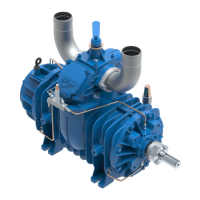http://www.jurop.it
e-mail: info@jurop.it
5.1. Pump starting-up
• Before starting the equipment check the lubricating oil level of the
pump.
• Refill the tank with lubrication oil.
• Check the oil level in the gear box (if the pomp is provided with it).
• In order to choose the most suitable oil, see paragraph. 2.5.
• Check that all protection and safety devices are correctly installed.
• Check that no obstacles obstruct the vacuum and pressure line or
the air injection cooling system.
• Check rotation direction: open all system valves and start running
at slow speed.
Do not rotate in the wrong direction:pump may be
damaged.
• Check which position of the 4-way integrated valve lever allows
vacuum or pressure functioning.
• If the pump has been in storage for a long time: inlet. liter of oil in
the pump for an easy cleaning of internal parts.
• Close the valve and increase vacuum rate (or operating pressure).
• Check loading and operating speed for vibrations or unusual
noises.
This vacuum pump is designed to work at
maximum speed. For longer operating we
recommend the pump be run at working speed.
• Prepare adequately transmission.
5.2. Operating precautions
• Run the vacuum pump at a room temperature of -20°C e +40°C.
• Do not make the vacuum pump overheat. Maximum air
temperature on exhaust (or delivery) side: 180°C.
• Do not operate the pump without lubrication: it may cause quick
wear and possible breakdown of vanes.
• Do not start running the pump under load: that causes stress to the
drive system and the hydraulic motor.
• Check rotation speed. The vacuum pump must never exceed the
maximum speed or run below the minimum speed.
• Do not accidentally operate the pump in the wrong direction: it may
break the vanes.
• Do not convey the exceeding delivery outlet towards the suction
port, otherwise it will sack warm gas.
• Control the air flow by adjusting the rotation speed: do not use the
pressure relief valve to discharge the exceeding flow.
• Once that the wanted vacuum rated has been attained it is
recommendable to decrease the speed. (see par. 2.3): This useful
procedure, that will not increase the time requested to fill up the tank,
will however result in a lesser wear of the vanes. It is suggested to
reduce the speed also when operating with pressure.
• When, exhaust temperature is reduced, vane durability is
increased and both oil consumption and power absorption are reduced.
Once the needed vacuum rate has been reached,
we recommend reducing the vacuum pump
speed to its working speed.
• Internal wash-up is necessary after prolonged inactivity, after
working in dusty environments or in case of accidental suction of
liquids. Such operation must be carried out only on cooled pumps.
1. Disconnect the exhaust silencer, if possible;
2. Start running the pump at low speed;
3. Suck some water (about 1-2 litres) through the inlet port;
4. Then suck oil (about 1 litre) to complete the wash-up and lubricate
internal components.
In case the exhaust line cannot be disconnected,
drain the liquids accumulated in the separator of
the exhaust silencer.
• After prolonged inactivity, suck some oil (about ½ litre) through the
suction connection to lubricate internal components.
• The air injection cooling system grants the use of the vacuum
pump at high vacuum rates. Anyway it has to be remembered that the
pump has been designed for non-continuous work. This cooling system
allows to dissipate part of the accumulated heat still at satisfactory
lubrication conditions. Continuous, heavy-duty work, or prolonged work
periods will cause an over-heating of the pump, consequently reducing
performances and durability.

